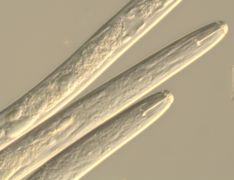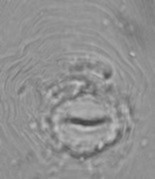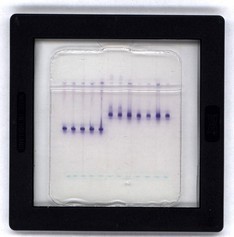The nematology laboratory identifies nematode species based on morphological, biochemical and molecular characteristics.
The morphological analyses of the nematodes are carried out using modern light microscopes. For each nematode species, we determine the morphometric parameters that are characteristic of that species. Based on the measured and visually determined parameters, the nematodes are assigned to a species.


Anterior part of Globodera spp. larvae Perineal pattern of the female of Meloidogyne spp.
Due to the large number of species and the greater morphological similarity between them, it is advisable to use an additional independent method for species identification in nematodes. For this purpose, biochemical (analysis of isoenzymes and total proteins by electrophoresis) and genetic approaches (mostly analysis of the ITS region of ribosomal rDNA or mitochondrial mtDNA by various molecular methods such as PCR, real-time PCR, PCR-RFLP and nucleotide sequencing) are used.

Electrophoregram of the esterase isoenzyme in Meloidogyne sp.
Isoenzyme gel electrophoresis method
The isoenzymes of malate dehydrogenase (MDH) and esterase (EST) are species-specific in root-knot nematodes. For identification, we use freshly isolated females from infested plant tissue, isolate the total proteins and separate them using protein electrophoresis. After the electrophoresis, we detect the MDH and EST spots with enzyme reaction and determine their migration coefficients. M. javanica electrophoretic sample is used for reference.
In addition to the identification of nematode species, we also advise our customers on suitable control and management methods for detected nematode species.
Prenos datotek
- Borova ogorčica PDF 530 kb
- Krompirjeve ogorčice PDF 680 kb
- Ogorčice koreninskih šišk PDF 433 kb